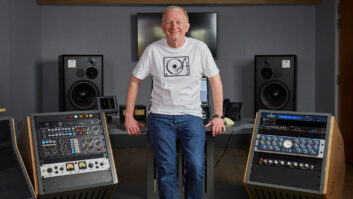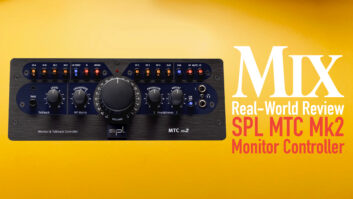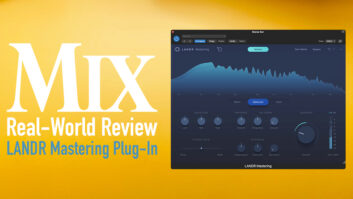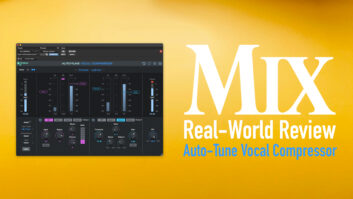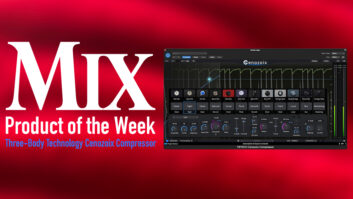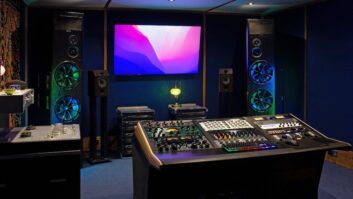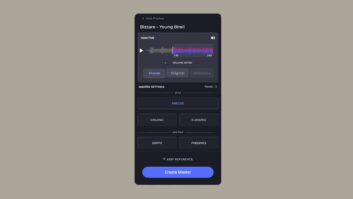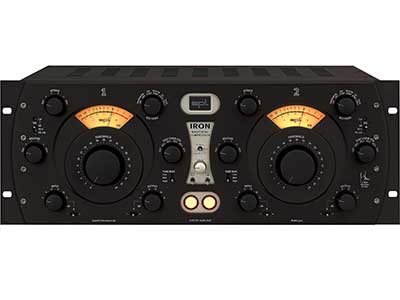
Sound Performance Labs’ Iron Model 1520 Mastering Compressor is a tube-based stereo compressor/limiter that pays homage to classic units of yesteryear by way of a whole new design and fresh approach in appearance, operation and sound. Weighting in at 11 kg, Iron comes in a 4U-high steel cabinet that’s available with either a matte black or red, machined-aluminum front panel. There are two large 42-step
(1 dB steps) Threshold controls for channels 1 and 2, two large custom VU meters, and two large lighted hardwire bypass buttons. All other controls are either rotary or toggle switches for precision recalls.
Both of Iron’s Input and Output controls are ALPS rotary switches with six positions each. By using a combination of the three-position C&K toggle switches with +, – and 0 (unity) positions, there is up to a ±12dB of gain range in 2dB calibrated steps. I liked that the VU meter always reads gain reduction or output level even while in hardwired bypass. The VU meter switches between GR and either VU 0dB, or VU +10dB ranges—which is perfect for setting hot levels to pro DAW interfaces.
After setting input level (Iron is strapped for 0 dB not +4 dB), the incoming audio signal is “monitored” by a PerkinElmer VTL5C1 Vactrol opto-isolator feed-forward peak limiter that’s not in the audio path. When input levels exceed +15 dB, the VTL5C1 reduces by shunting the signal to ground. Then a custom-made Lundahl transformer splits the signal to feed the cathodes of a variable-mu remote cutoff 12AU7 connected in parallel with a carefully matched, sharp cutoff 12AX7. Called a variable-bias limiter/compressor, there are two tubes per channel, with the control voltage applied to their grids simultaneously.
The control voltage is derived from a combination of Threshold setting, Attack and Release time setting, the Side-Chain EQ section (if switched in), one of three Tube Bias voltage toggle switch choices, and one of six Rectifier choices.
Audio signals must be first rectified into DC to be turned into a control voltage, and Iron allows a choice of the rectifier diode and smoothing capacitor value (required for DC rectification) to set the style, shape, response time and character of the control signal and therefore compression.
The Rectifier section has six rectifier diode/capacitor combinations in this order: two Germanium choices with 1mf or 2mF caps; an LED with 3.3mF; Silicon with 330nF, another Germanium with a 220nF cap; and a Silicon/Germanium combination with a 100nF capacitor.
The first five choices have response curves that go from 0.1 ms to 5 seconds. The last position uses a Germanium and Silicon combination for the fastest response time of 0.2 ms to 300 ms. SPL recommends the middle LED rectifier as a good starting position; I found faster rectifier Attack/Release characteristics when switching toward the right and slower rotating to the left.
Sidechain EQ
There are five sidechain EQ positions: Off (actually a 20Hz HPF is in circuit all the time), EQ1, EQ2, EQ3, EQ4 and Ext. Designer Wolf Neumann came up with the four sidechain equalizer curves empirically during his mastering sessions using Iron over the last three years. I referred often to the included curve drawings in the manual; they are not typical sidechain curves.
The Ext position switches to a rear panel ¼-inch TS unbalanced sidechain input for connecting your own sidechain EQ or introducing any signal to cause gain reduction. I tried this path by connecting a bus output from the studio’s console to cause Iron to duck down a backing track for a voice-over and it worked well, with the ability to control the fade-up time using the Release control.
I found it odd that the sidechain circuit is an unbalanced path over a single TS jack. There is also no ability to link multiple Iron compressors for surround mixing. If nothing is plugged into the rear jack, switching to Ext offers a way to pass audio through Iron for its sound without any compression.
For stereo linking, Iron’s Channel 2 controls Channel 1. All settings are linked except for the Input and Output rotaries. Iron uses a single toggle for choosing either of two output EQs. AirBass is a smooth “smiley curve” with gentle shelving boosts starting from 5 kHz up to 15 kHz and from 200 Hz down to 50 Hz. The Tape Roll-Off filter is a subtle rolloff of -1 dB by 25 Hz and -2 dB by 15 kHz. These EQs are placed after the Lundahl output transformers and before SPL’s 120-volt DC Audio Rail SUPRA output op-amps.
Auto Bypass is for “hands-free” A/B’ing between hardwire bypass and Iron in circuit. Automatic bypass is adjustable from 2.5 to 12 seconds, and, once engaged, it continues to cycle back and forth until you turn it off. I think that the large bypass buttons should also light up when in/out of circuit just as when manually toggling Iron in/out.
Using Iron
In the beginning, arriving at a compression setting involves some experimentation, but in time I gained an understanding of how all the different parameters interact and affect the sound.
I found when auditioning the sonic differences between the Rectifiers, it was easier if I set the unit’s Attack time to position 2 or 3 (1 being fastest) and the Release time to 1. Starting this way, the compression action is mostly dependent on the Rectifier’s time constant. The manual has a chart of approximate time values using any of the six rectifiers along with each of the six, Attack/Release time positions.
The first three Rectifier positions produced a clear attack with the main differences being the 1 mF being the fastest recovery and the slowest at 3.3 mF for the LED. Generally for program compression, the LED rectifier emphasized the low frequencies in a very solid and flattering way.
By juggling and auditioning different combinations of Attack, Release, Rectifier, Side-Chain Filter, Threshold, and Tube Bias settings, I had a whole range of compression styles, colors and variations, from very subtle to extreme. Tube Bias arbitrates the final degree or range of compression. With the rest of the controls kept the same, higher bias causes more gain reduction. I would start on High to dial in compression and generally back it down.
My first use was for a drum bus compressor. Even with extreme squashes, it is hard to get Iron to distort audibly. Iron fattened up the size and width of the drums in a super Hi-Fi way using 1 to 10 dB of compression using Side-Chain EQ1 preset. This preset is flat in the low frequencies, but its 700Hz peak caused more compression of the boxy part of the (drum) room, and the dip at 2.4 kHz going to nearly flat by 5 kHz kept the high frequencies open and transparent. Amazing!
Iron inserted across the stereo mix bus in Pro Tools | HDX 12 set as a leveling amp was a perfect fit for a hip-hop track that already had minimal dynamics. I set the Attack time to position 2 or 3 and Release time to position 3 or 4 and used the Germanium/2mf rectifier. Using sidechain EQ3 that boosts the sub bass but has a dip at 175 Hz, I went with as much as 9 dB of gain reduction and the track pumped like it was going to burst at the seams! Awesome!
I tried it on a lead vocal. Sidechain EQ4 has a lift in the bass causing a little more compression overall (and sometimes necessitating a new Threshold setting), but it also has a broad dip at 3 kHz followed by a shelf boost starting at 4 kHz. This curve caused Iron to compress more whenever the singer got shrill and reedy-sounding, yet kept the sound open and transparent. Iron would be my first choice for compressing any singer.
SPL’s Iron allows sculpting compression at the circuit design level. I could customize this compressor very specifically to produce the perfect style and amount of processing for any job. Iron is a powerful instrument for mastering, mixing or recording, and it’s difficult to get a bad sound on any source, from full stereo mixes to vocals to drums to acoustic guitars. Incredible kit!
Barry Rudolph is an L.A.-based engineer and educator. You can visit his website at www.barryrudolph.com.
Try This
You can do parallel compression SPL Iron-style by feeding the same signal to both channels at the same time. I unlinked them and sent a direct Fender bass track to one side with typical light compression settings. But the other side I cranked right up with max Input and the Threshold dialed “flat out” maximum using the Silicon/330nf rectifier. By blending the two outputs, I was able to get any combination of bass sounds from clean to crazy.
PRODUCT SUMMARY
COMPANY: Sound Performance Labs
WEBSITE:spl.info/en
PRODUCT: Iron Mastering Compressor
PRICE: $4,999 MSRP
PROS: Super top-notch, precision sound and infinite adjustability
CONS: An expensive and large unit, unbalanced sidechain input
